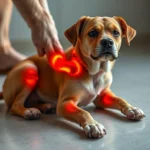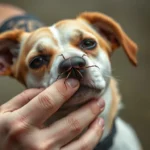
Introduction
Dog health care is a crucial aspect of responsible pet ownership. Just like humans, dogs can suffer from a range of health issues, some of which may be preventable with proper care and attention. Among these concerns is the question of lice infestation. Understanding whether dogs can get lice from humans is essential for pet owners who wish to maintain their dogs’ health and well-being.
Lice infestations are not just a nuisance; they can lead to discomfort and more serious health issues if left untreated. In this article, we’ll explore the nature of lice, how they affect dogs, and what pet owners can do to prevent and treat lice infestations.
Understanding Lice
What are Lice?
Lice are tiny, wingless insects that live on the skin or hair of their host. There are two main types of lice: biting lice and sucking lice. Biting lice feed on the skin and debris, while sucking lice attach to the skin and feed on the host’s blood. Both types can cause irritation and lead to secondary infections in dogs.
The lifecycle of lice consists of three stages: egg (nits), nymph, and adult. Nits are laid on the hair shafts and can be challenging to detect. Once they hatch, the nymphs mature into adults within a few weeks, and the cycle continues if not addressed.
Lice Infestation in Animals
Lice infestations are not limited to dogs; they can affect a range of pets, including cats, rabbits, and even livestock. Dogs typically experience infestations of biting lice, which can thrive in environments where hygiene is lacking.
Signs of lice infestation in pets may include excessive scratching, hair loss, and skin irritation. Recognizing these symptoms early is essential for effective treatment.
Can Dogs Get Lice from Humans?
Transmission of Lice
The primary question at hand is whether dogs can get lice from humans. Generally, the answer is no. Lice are species-specific parasites, meaning that human lice (Pediculus humanus) do not infest dogs. Dogs can only be affected by their specific types of lice, such as Trichodectes canis, which is a biting louse.
While lice may transmit between different animals, the risk of transmission from humans to dogs is negligible due to the differences in biological makeup and the specific types of lice that affect each species.
Scientific Evidence
Scientific studies support the notion that lice do not cross species barriers easily. Experts assert that the anatomy and biology of human lice differ significantly from dog lice, making it improbable for lice to transfer between these species.
Research indicates that while lice can spread among dogs and other animals, the direct transmission from humans is not a recognized concern. Therefore, pet owners can rest assured that their dogs are safe from human lice.
Symptoms of Lice in Dogs
Recognizing the symptoms of lice infestation in dogs is crucial for prompt treatment. Symptoms may include:
- Excessive scratching: Dogs may scratch more than usual, indicating irritation.
- Hair loss: Patchy hair loss may occur as the dog scratches or bites at the affected areas.
- Red or inflamed skin: Lice can cause allergies and skin irritation.
- Visible lice or nits: In severe cases, lice or their eggs may be visible on the dog’s skin or fur.
It’s essential to differentiate these symptoms from those caused by other skin conditions like allergies or flea infestations. If you notice any of these signs, consult your veterinarian for accurate diagnosis and treatment.
Prevention of Lice in Dogs
Hygiene Practices
Maintaining good hygiene is vital for preventing lice infestations. Regular grooming helps to keep your dog’s coat clean and free of debris. Brushing your dog’s fur not only removes loose hair but also helps you spot any potential issues, including lice or other parasites.
Additionally, keeping your dog’s living environment clean is equally important. Regularly wash bedding, toys, and other items your dog frequently comes into contact with to minimize the risk of lice and other pests.
Regular Health Check-ups
Routine veterinary visits play a crucial role in early detection and treatment of potential health issues, including lice infestations. During these check-ups, your veterinarian can conduct thorough examinations and recommend preventive treatments, such as topical treatments or oral medications.
Vaccinations also contribute to your dog’s overall health, making them less susceptible to various health concerns, including skin conditions.
Avoiding Infestation
If you have multiple pets, it’s essential to monitor their health closely. Lice can spread from one pet to another, so keeping an eye on all your animals is crucial. If one pet shows signs of lice, isolate them from others to prevent further spread.
Educate yourself about the signs of lice in other pets and take prompt action if you suspect an infestation. Regular grooming and health checks for all pets in your household can help mitigate the risk of lice transmission.
Treatment Options for Lice in Dogs
Over-the-Counter Treatments
Several over-the-counter treatments are available for lice infestations in dogs. These treatments typically come in the form of shampoos, sprays, or topical solutions designed specifically to kill lice and their eggs.
It’s essential to choose products that are labeled for use in dogs, as human lice treatments can be harmful to pets. Always read and follow the instructions carefully, and consult your veterinarian if you’re unsure which product is best for your dog.
Veterinary Treatments
In more severe cases, or if over-the-counter treatments do not yield results, it’s advisable to consult a veterinarian. They can prescribe stronger treatments, such as topical medications or oral therapies that are specifically formulated to target lice.
Veterinarians can also provide guidance on the proper use of these medications and any follow-up care required to ensure the infestation is fully resolved.
Home Remedies
Some pet owners may prefer to explore home remedies for lice treatment. Natural alternatives like neem oil or apple cider vinegar have been suggested, but their effectiveness can vary.
If you choose to go this route, it’s crucial to proceed with caution. Always conduct patch tests before applying any home remedy to your dog’s skin, and avoid using essential oils without veterinary advice, as some can be toxic to pets.
Related Health Concerns
Other Parasites in Dogs
While lice are a concern, they are not the only parasites that can affect dogs. Common parasites include fleas, ticks, and mites, each presenting its own set of challenges. Fleas and ticks, for example, can carry diseases and cause allergic reactions, making their prevention just as important.
Understanding the differences between lice and other parasites can help dog owners identify problems more quickly. For instance, fleas tend to cause more widespread itching and irritation, while lice infestations may be more localized.
Skin Health in Dogs
Maintaining skin health is vital for your dog’s overall well-being. Regular grooming not only helps prevent lice and other infestations but also keeps your dog’s skin healthy. Conditions such as allergies or dermatitis can mimic lice symptoms, so it’s essential to consult with a veterinarian if you notice any changes in your dog’s skin or coat.
Conclusion
In summary, while dogs can get lice from humans is a common concern among pet owners, the scientific evidence suggests that the risk is minimal. Understanding lice and their effects on dogs is crucial for prevention and treatment.
Regular grooming, hygiene practices, and routine veterinary check-ups can significantly reduce the risk of lice infestation. If you suspect your dog has lice or another skin condition, consult your veterinarian for guidance and treatment options.
By prioritizing your dog’s health and well-being, you can help ensure they lead a happy and comfortable life.
FAQs
Can dogs get lice from other pets?
Yes, dogs can get lice from other infected pets. Regular monitoring and hygiene practices can help reduce this risk.
How can I tell if my dog has lice or fleas?
Look for symptoms like excessive scratching, hair loss, and visible lice or nits. Fleas typically cause more widespread itching and may leave flea dirt in your dog’s coat.
What should I do if I suspect my dog has lice?
Consult your veterinarian for a proper diagnosis and treatment plan. Early intervention can help prevent further issues.
Are there any breeds more susceptible to lice?
While any dog can get lice, some breeds with denser coats may be more prone to infestations due to the difficulty in grooming and spotting lice.
By taking the right precautions and remaining vigilant about your dog’s health, you can help protect them from lice and other health issues.









